

A vast subject of study that encompasses artworks across time and culture in the Subcontinent, Indian miniature painting as a tradition includes small-scale paintings and manuscript illustrations as well. Miniature paintings was born here during the literary boom of Buddhism and Jainism between the 9th and 12th centuries. The 3-inch palm leaf manuscripts were minuscule and intricate, especially when compared to the large-scale wall paintings that preceded them. In the 15th century, when paper was introduced in India and became the medium for manuscripts, indigenous painting styles reached the height of their development and the size of the paintings became irrelevant. An entire century later, a fusion of Persian and indigenous art styles emerged and reached new heights under Mughal patronage. These were even further away from palm leaf manuscripts.
Indian miniatures are flat
or lack perspective in their visual grammar.
The foreground, middle ground and background all appear equally important to the viewer.
Even when the wide-eyed figures of the 9th century evolved to naturalism under
Jehangir, the miniature
lacked realism.
Miniatures can be defined as narrative paintings.
Like most indigenous art, miniatures portrayed a scene or story to the viewer.
Hunting scenes, court scenes and mythology were some of the most recognisable themes in Indian
miniatures.
The process behind the art was as significant, if not more so, than the
iconography. Preparation of colours was crucial; colours were created by hand using organic, earth and
mineral pigments.
Indian miniatures are decorative and include fine details in costume, architecture, patterns and shadows
created by flora and fauna.
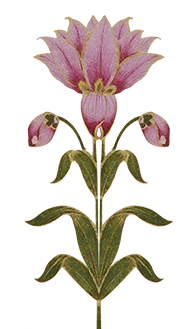
Illustration part of the book 'Hamzanama' or 'Dastan-i-Amir Hamza', Mughal India, Opaque
pigments heightened with gold on cloth c. 1560-1575 © Sarmaya Arts Foundation

The manuscript is centred around the adventures of Prophet Muhammad’s
uncle, Amir Hamza, who sought to convert the world to Islam. The story is considered
factual,
interwoven as it is with local legends and popular tales.The manuscript was painted by local
miniature artists supervised by Persian masters Mir Sayyid Ali and Abd as-Samad, who
followed
Humayun from Iran to India. At least 50 artists were employed for this project,
producing 100
illustrations per volume; this is how Akbar’s reign saw the establishment of
karkhanas or
workshops for artists to work collectively.
This folio of A man sleeping in a pavilion is a beautiful representation from the
Hamzanama
series. It uses intricate decoration, disregards perspective and boasts the finesse
of a Persian
miniature. But the choice of bolder colours like saffron against the red quilt
betrays the
influence of local styles. The choice of colours, however, may not have been
intentional. The
unavailability of subtler colours in India, such as zinc white, played a role in the
limited
palette of this folio and of the commission at large.
Rajasthani Miniature, Jaipur style, Opaque pigments on paper c. 1750-1770 © Sarmaya Arts Foundation

Jaipur was the closest to the Mughal seat of power Agra/ Delhi, and the Rajput and Mughal
families were tied together in marriage beginning in the late 16th century.Jaipur also had an
alliance with the Mewar, where Maharaja Madho Singh of Jaipur (r. 1750-68) spent his
formative
years.Under the patronage of Madho Singh I and his son Pratap Singh (r. 1778-1803),
Jaipur
became one of the most well-known styles in Rajasthani miniature paintings.
This painting of Dilsringar, the steed of Sawai Pratap Singh, is set against a sublime
flat
green and is a remarkably realistic image of a horse. The realism is typical of the
Mughal
style, with the Rajput court paintings being less defined and flat in appearance. The
colour and
design of the saddle align with the palette of Jaipur. The composition is finished with
a
midnight blue border, a favourite colour of Udaipur (Mewar) painters.
Rajasthani Miniature, Mewar School, Opaque pigments on paper c. early 19th century © Sarmaya
Arts Foundation

Maharaja Bhim Singh (r.1778-1828) was one of the liveliest patrons, with an obsessive
interest
in portraits of himself — whether a court scene, a hunting scene or a modest one where the
Maharaja carries on with his daily activities. Here, for example, he is shown leading a
procession outdoors.The painting uses isolation of colours and patterns — for example
the clear
division of mountains, the flat blue backdrop and the ground. The artist also uses the
colour
white in abundance and plays with scale. These were the characteristics of Mewar
paintings in
the late 17th and early 19th centuries, a composition popularised by Mewar artist Bagta
and
carried on by his younger son Chokha. The latter created several paintings of Maharaja
Bhim
Singh.
The halo, the size of the emperor and his ornate horse all indicate the princely stature
of the
figure. The painting carries an inscription on top, a distinct feature in Rajasthani
miniatures,
which would detail the event, the individual, the date and the artist.
Opaque pigments on paper c. early 19th century © Sarmaya Arts
Foundation
The Rajasthani school of painting defined individuality only through distinctive features
like
moustache or body size. Other physical traits of the kings remained more or less the same,
which
is why inscriptions were needed to identify the subject of the painting.This untitled miniature
may be attributed to either Raja Bhim Singh or Jawan Singh from Mewar, and bears several
similarities to the painting titled 'Maharaja Bhim Singh in procession on horseback,
accompanied
by attendants on foot Udaipur':
- It plays with scale and colour isolation
- White and blue are the dominant colours in the composition
- There is a crescent moon-like shape visible right next to the king
Even after noting all these similarities, there is no certainty that the artist of the
two Mewar
paintings was the same. The Rajasthani miniature stressed on similarities instead of
differences
in its compositions. If the artists Bhagta and Chokha gained popularity in the court of
Mewar,
then regional artists followed court standards.
Opaque pigments on paper c.20th century © Sarmaya Arts Foundation
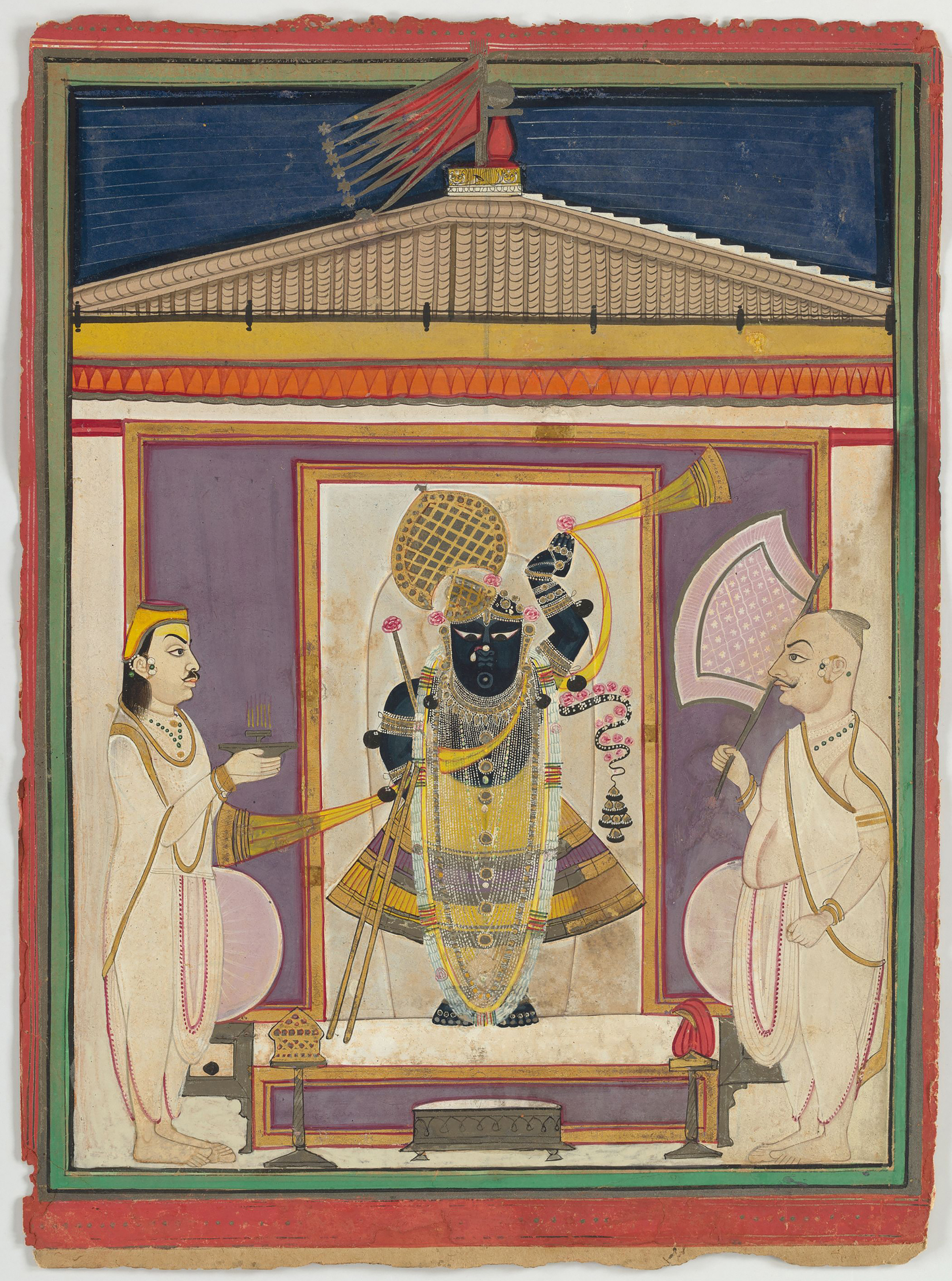
Religious themes were a big part of the Rajasthani miniature school. The first known
commission
is a series from the Bhagavata Purana c. 1525, possibly patronised by the Rana Sanga of
Mewar.
In every miniature tradition in Rajasthan, the tales and rupas of Krishna were
illustrated, but
Nathdwara (a city north of Udaipur) became the spiritual home of Shrinathji and the
centre of
religious patronage.
Several artists moved to Nathdwara as a result, and popularised the cloth painting
tradition of
Pichwai. This new style of painting was influenced by the artists of Mewar, Kishangargh
and
Kota. As a result, the original Pichwai comes with a window cut out (similar to the
blank space
seen here behind the artists) for the idol to fit through. As devotees and patrons
wished to
keep souvenirs of their pilgrimage, a need for miniature cards arose in the city.
Opaque pigments on paper c.20th century © Sarmaya Arts Foundation
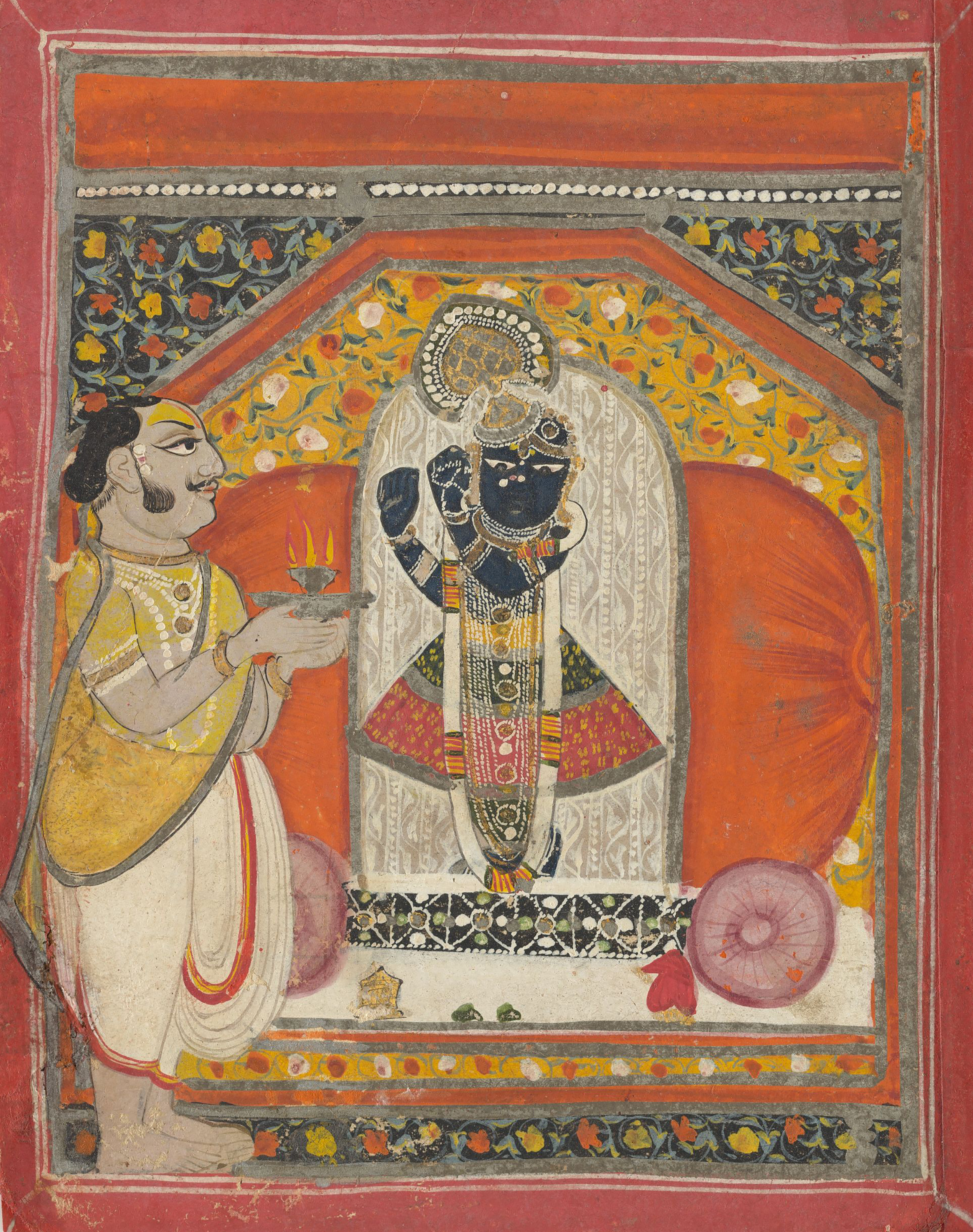
The miniature cards of Nathdwara are the closest to indigenous techniques and colours when
compared to any other school of miniature painting in Rajasthan. They are smaller than the
average miniature painting: the one shown here, for instance, is 15.5 cm in height and 12 cm
in
width. The paintings are adorned in colours and the
flowers of spring associated with the
festival of Holi. To the left stands the tilkayat or chief priest of the temple of
Shrinathji
and to the right would stand the patron. However, the patron could request the artist to
paint
them in the likeness of a priest, shown in devotion to the Lord.
The miniature cards began to be sold near temples and in bazaars thanks to the influx of
people
to Nathdwara. The patronage for these miniatures cards came from common people like
merchants,
businessmen and women as well as traders and others. After the invention of the camera,
versions
of the miniature cards where people collaged their photographs into the composition
became a
popular souvenir format.
Gopa Trivedi, Gouache on Wasli, 2018 © Sarmaya Arts Foundation
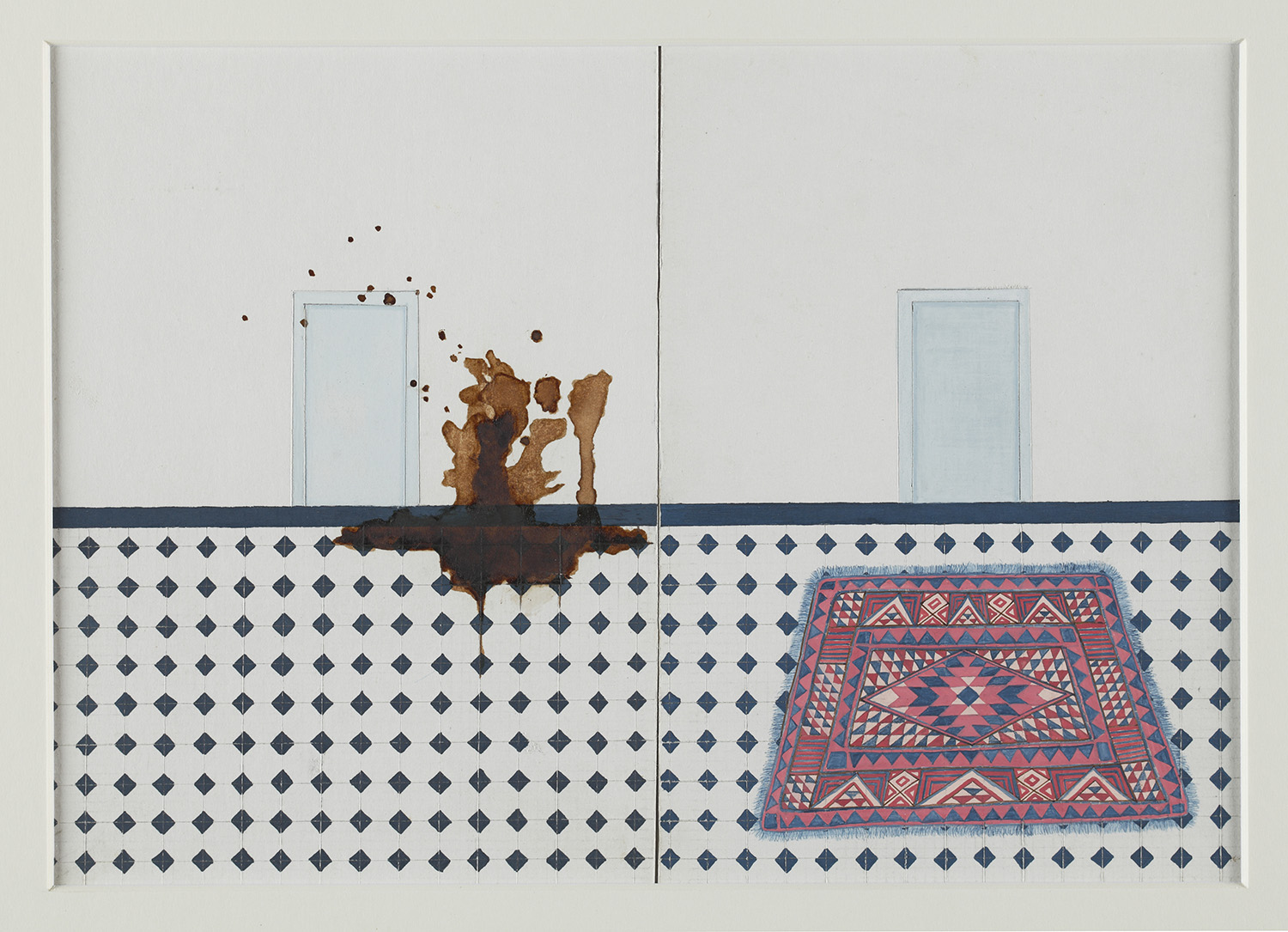
The miniature tradition lives on today in the art practices of several modern and
contemporary
artists. The roots of Persian and Rajasthani miniatures can be seen in the practice of
Delhi-based artist Gopa Trivedi. “With miniatures,
I found my medium,” the artist told Sarmaya
in an interview. Just like the court painters of the Indian miniature school, Trivedi
makes her
own wasli or canvas and sometimes even creates her own colours. An internship at a
karkhana in
Jaipur acquainted the artist with the time-honoured craft processes behind
miniatures.
Trivedi even takes on the narrative style of Indian miniature painting. In this series,
the
progression of the narrative can be seen from one painting to another, just like a
manuscript.
The story progresses as you flip the pages. Trivedi’s practice in some ways also
contrasts or
reinvents the miniature style; her work is minimalist and showcases ordinary or everyday
objects
and (secular) spaces. The themes are centred around their infiltration, degeneration or
erasure.
Indigo dyed cotton cloth, natural pigments and raised gold on wooden backing, 21st century ©
Sarmaya Arts Foundation
Born in Leeds, England, Desmond Lazaro travelled to India to pursue his masters at MSU
Baroda.
Here, he became captivated by the traditional Indian Pichwai from Rajasthan. Lazaro learnt about
miniature painting techniques in great detail by studying for 12 years under the
guidance of
Jaipur Master Banu Ved Pal Sharma, a living expert on the miniature and Pichwai style.
This is
why Lazaro employs stringent processes like pigment and brush-making, cloth-dyeing, the
use of
gold leaf and more. The artist marries miniature iconography and process with star maps,
his
personal journeys and the journeys of explorers.
In Mapping the Heavens, Lazaro uses indigo-dyed cotton cloth reminiscent of the midnight
blue
used in Mewar, with natural pigment. The contrast of blue and gold was commonly used for
religious paintings. They represent the infinite (blue) and the finite (gold), the
heavenly and
mortal realms. The work draws inspiration from his travels around Dunhuang in western
China,
particularly his trip to the Margao Buddhist cave where the oldest star map was
discovered. In
accordance with his interest in the ancient and contemporary universe, Lazaro’s painting
showcases mythological creatures representing the zodiac signs and an empirical view of
the
heavens.
Natural pigment and gouache on hemp paper, 2019 © Sarmaya Arts Foundation

Another artist based in the UK chanced upon the Indian miniature tradition by accident.
Jethro
Buck came to India as a traveller in 2010 and stumbled upon the Udaipur karkhanas. Buck
became
mesmerised by the processes involved in pigment-making, outlining a court scene, filling in
the
intricate patterns. For him, it felt like peering
back through time into the ateliers of the
Mughal and Rajput courts. The artist then applied for a grant in India to learn
miniature
painting and was tutored by Ajay and Vineet Sharma, master artists from Jaipur.
He believes that his art transcends cultural and political boundaries. From these ideas
comes
his painting Ways of Seeing. The title comes from the book and series by John Berger, an
art
critic in the 1970s, and speaks to the idea of how one symbol or visual is interpreted
in
different ways by different people. The tigers here are that one visual reinterpreted
across
cultures, tradition and mediums of visual art, represented in Rajasthani textiles (top
right),
Rajasthani Kota miniature drawings (middle left), Bengal Pattachitra (middle right),
Pahari
miniatures (left bottom), Korean folk paintings (right bottom) and even a photographic
print
(top left).
Oil and 22 3/4 ct gold leaf on Gesso Panels, 2019 © Sarmaya Arts Foundation
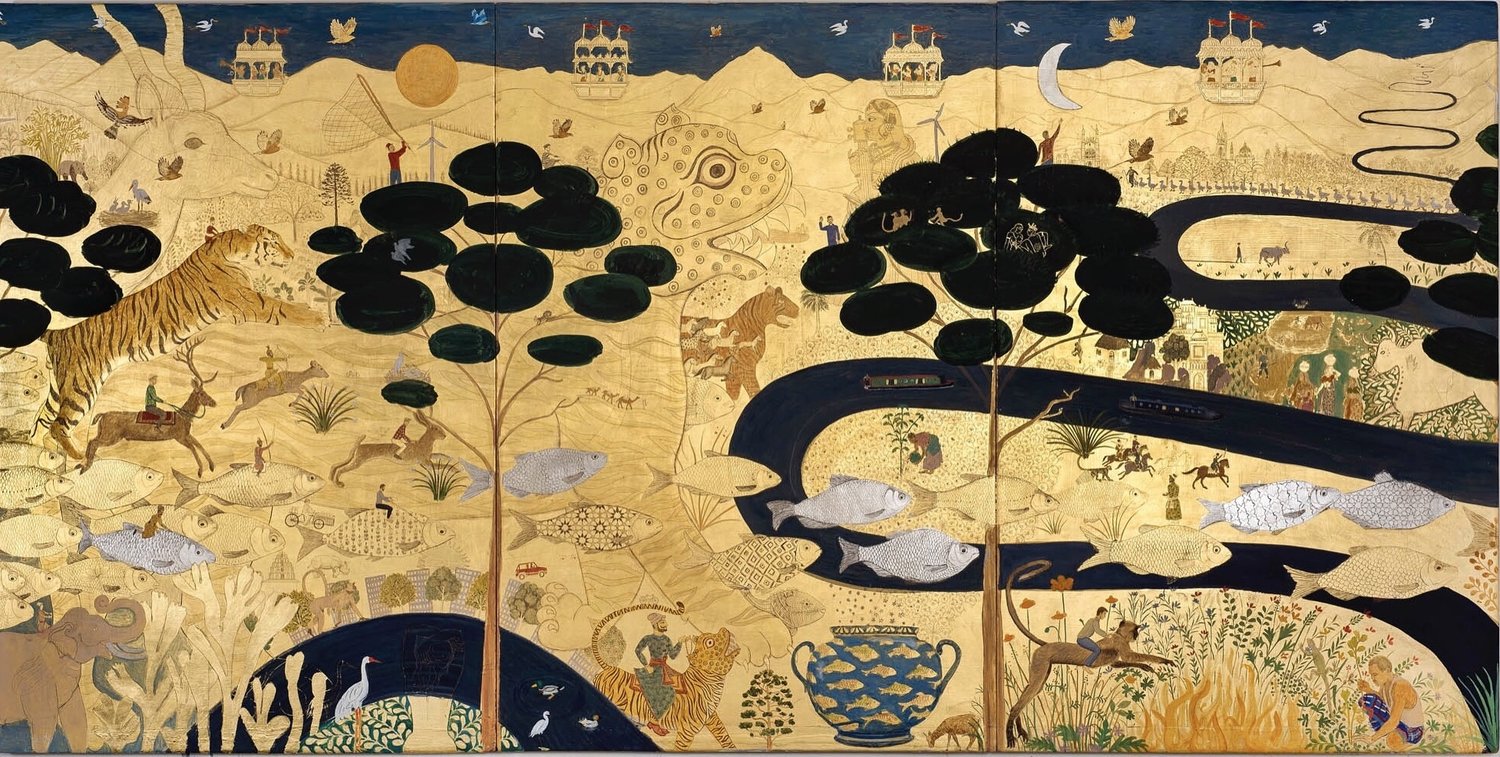
With his monumental work scaling 3 feet in height and 6 feet in width, Jethro Buck’s Wild
Things
turns the word ‘miniature’ on its head. Created using oil paint and 22 ¾ gold leaf on Gesso
panels, it borrows and meshes together a potpourri of images from across the global
landscape –
pastoral England to Mughal India.
In the miniature-style painting, animals and humans are seen hunting, tending to farms
or
strolling in lush green forests and arid desert lands. “It’s a call for reconnection,
both
literally, like we need to get back out there and back into the natural environment, but
also
symbolically and culturally,” says Buck. His artistic practice and this work stress on
the need
to preserve tradition, and on this large canvas the natural/manmade, traditional/modern,
east/west worlds collide. However, to view these worlds one must get past the dreamy
elements
that capture the imagination, like the swimming school of fish or the magnificent golden
tiger.
In many ways the iconography, colour palette and intricacy betray the miniature. From
3-inch
palm leaf to a 6ft-wide Ges'so panel, Wild Things scales the grandeur of Indian
miniatures.